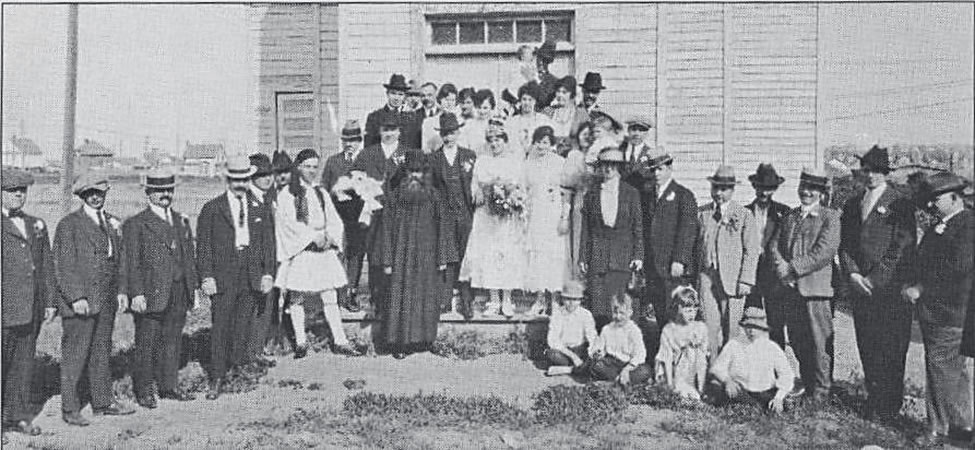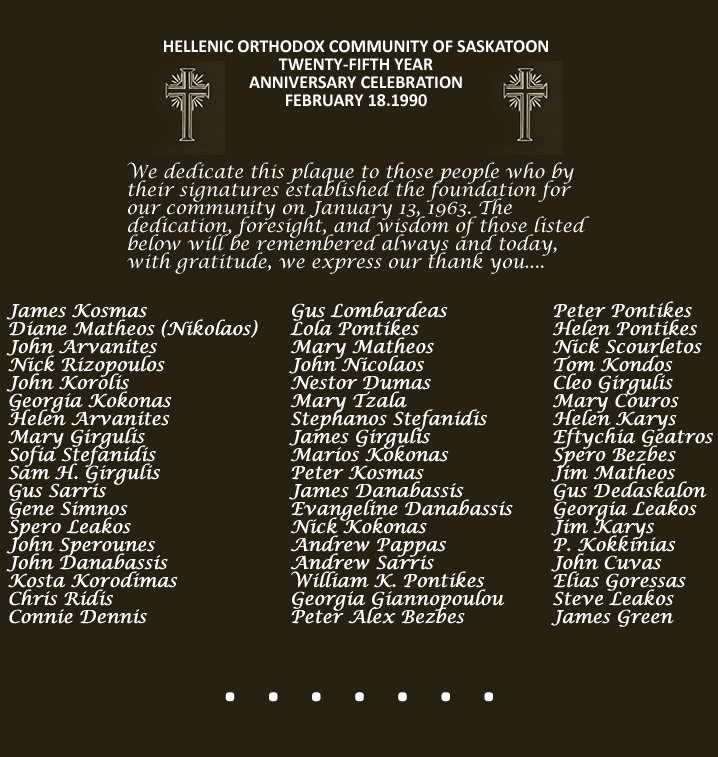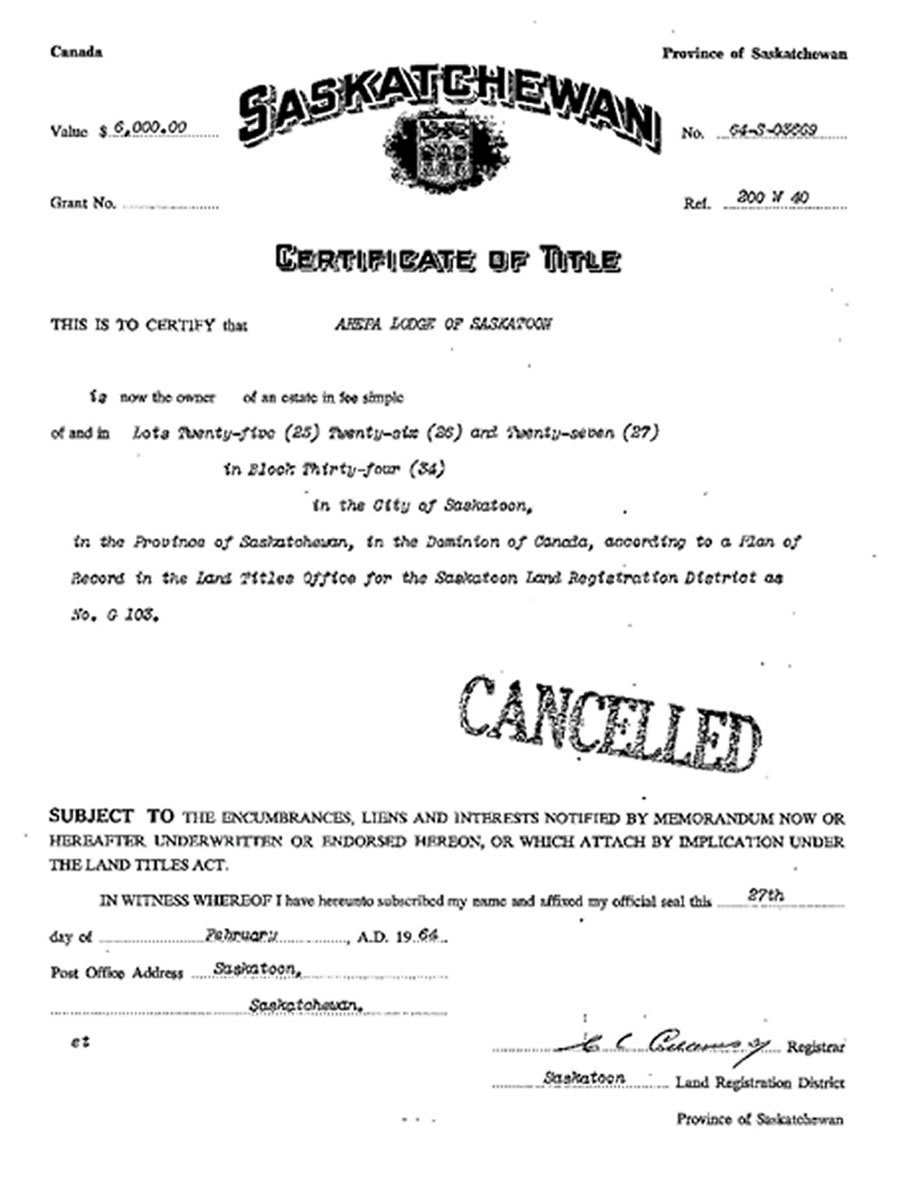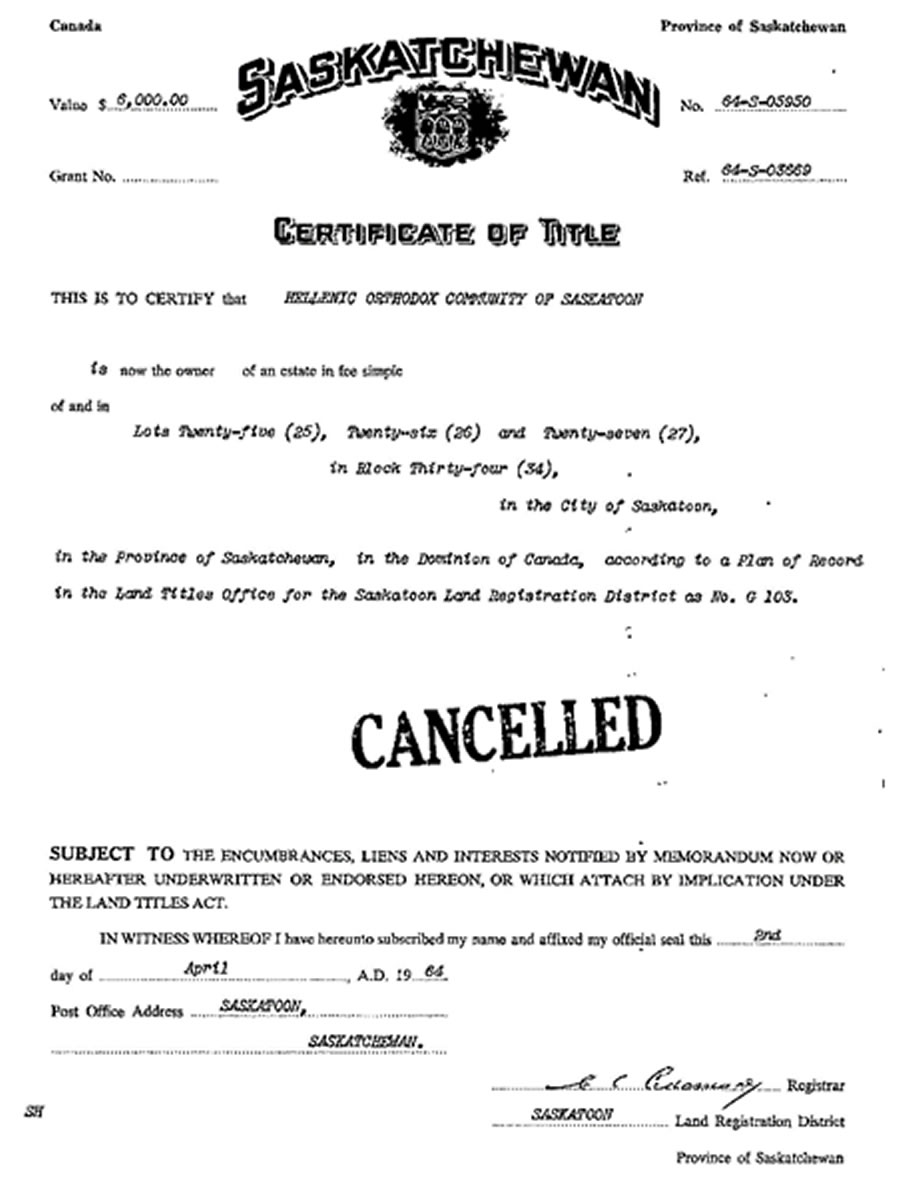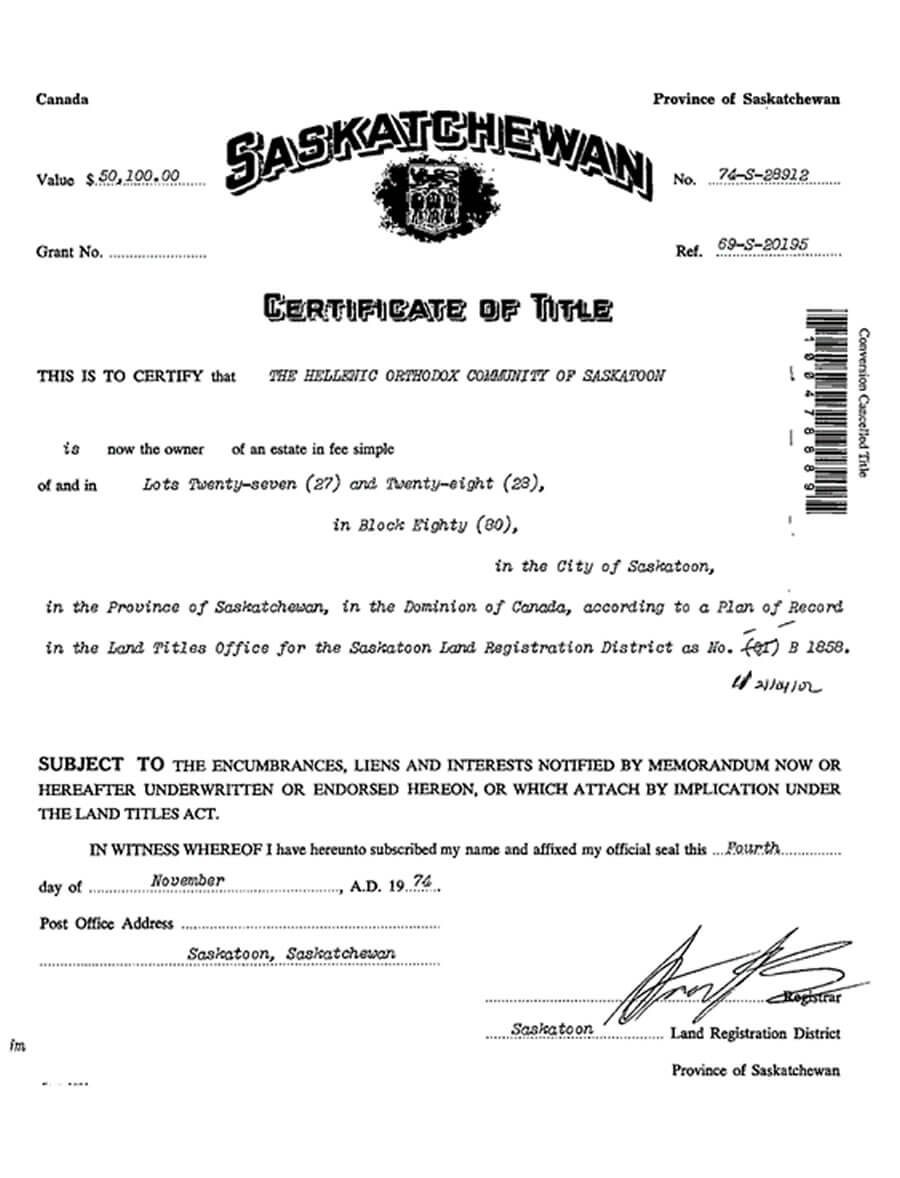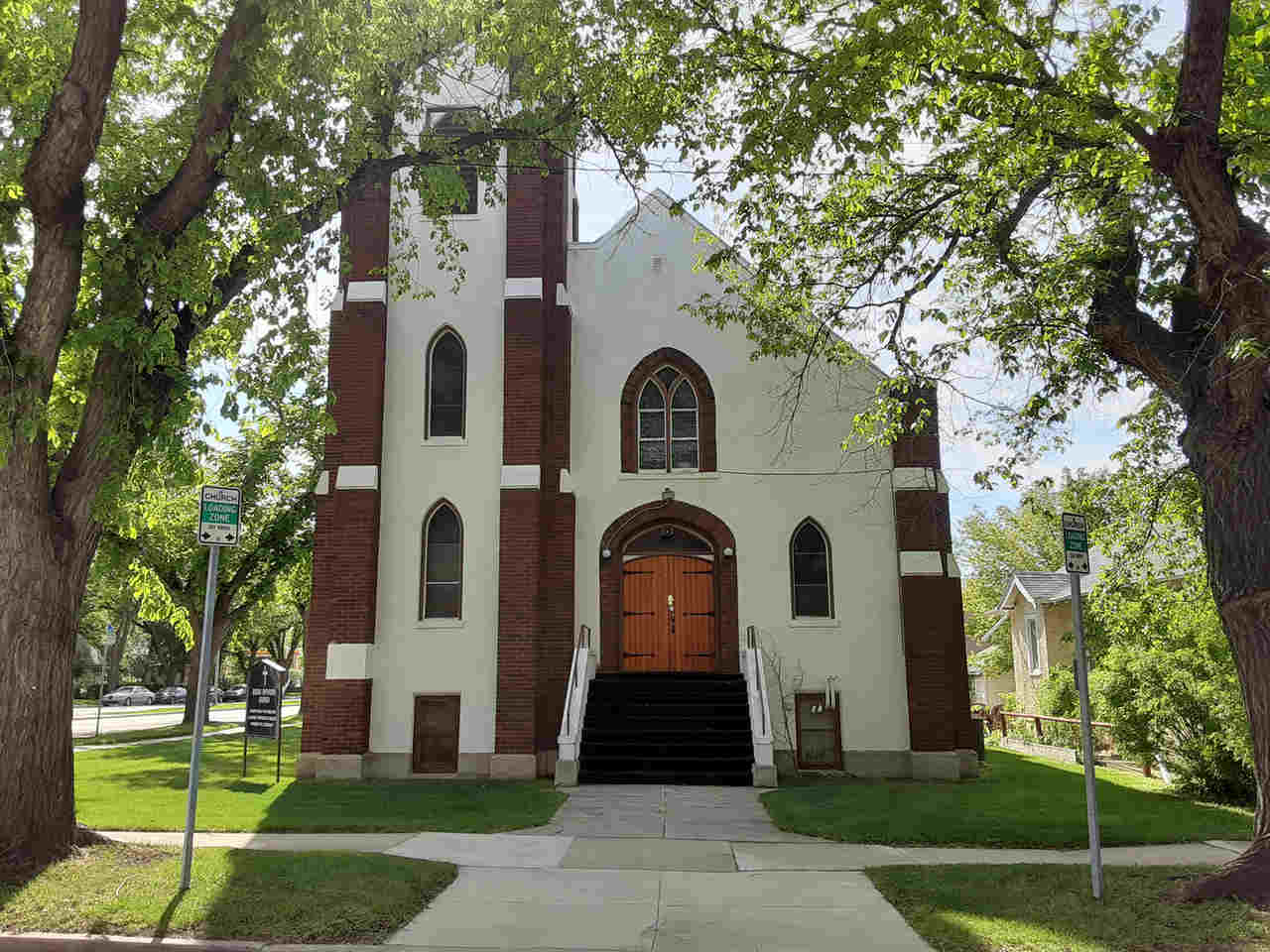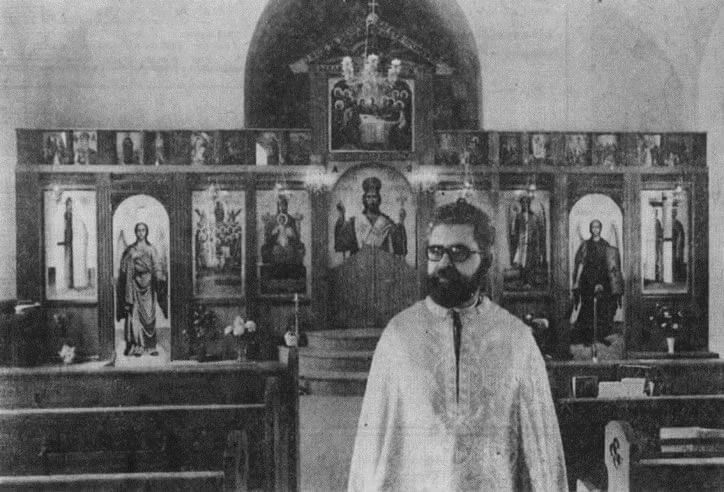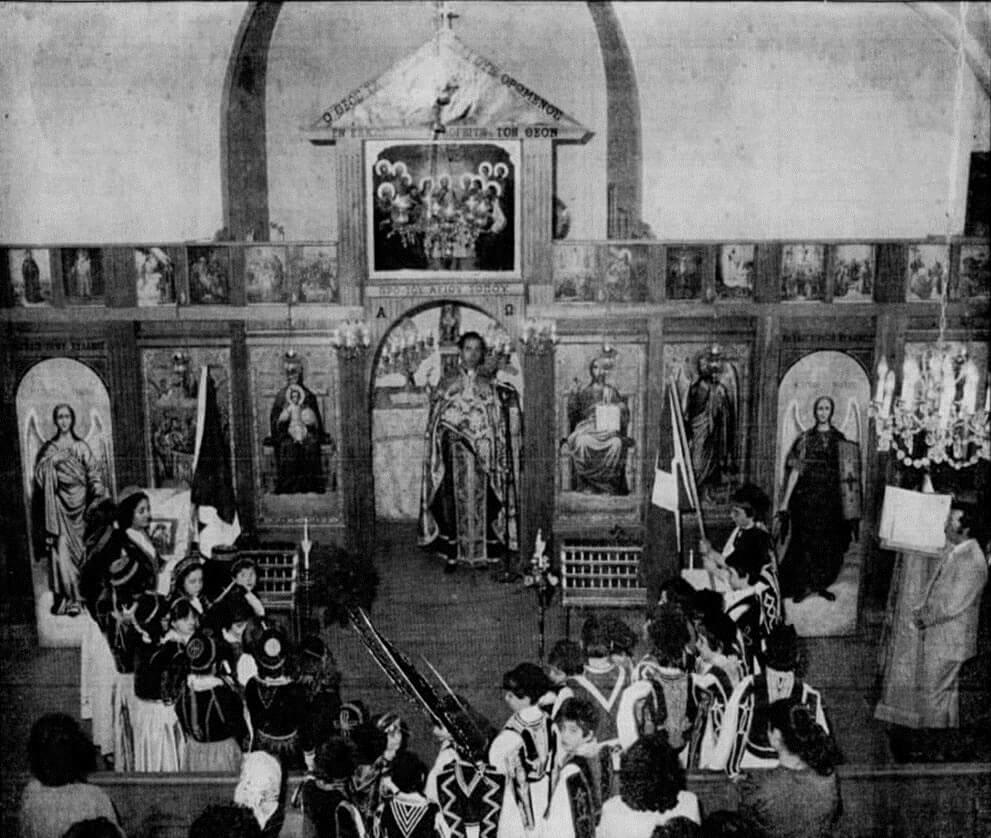Saskatoon’s Hellenic Orthodox Churches – History
Prior to 1964, Greek families in Saskatoon attended services in local Ukrainian Greek Orthodox churches. Weddings and funerals were also conducted at St. John’s Anglican Cathedral on Spadina Crescent East. However, many services such as baptisms occurred in the AHEPA Hall and in the banquet rooms of Greek restaurants.
Wedding of Nick Kangles and Triantafilli (Rose) Georgoulis, August 29, 1921 at Ukrainian Greek Orthodox Church, 310 Avenue P South, Saskatoon
The service was performed by Rev. Glishene Poppon of the Romanian Greek Orthodox Church in Regina; the koumbaro (best man) was Thomas Smith of Moose Jaw; the brother of the bride, James Girgulis, was dressed in the Evzone uniform of the Greek militia.
Source: Saskatoon’s Greek Community – The Pioneers (1901-1949)
In the early 1960s, a group consisting of Bill Girgulis, Cleo Girgulias, Gus Korodimas, and Lola Pontikes began preparing a draft constitution and bylaws to create the Hellenic Orthodox Community in Saskatoon. A general meeting, held on January 13, 1963, resulted in the adoption of the governance documents and the election of its first board of directors with Peter Pontikes as president, Spero Leakos as vice-president, and Cleo Girgulis as secretary. The following residents of Saskatoon signed the incorporation application for the “Hellenic Orthodox Community of Saskatoon”. The application was sent to the Government of Saskatchewan in 1963:
Source: Koimisis Tis Theotokou Greek Orthodox Church
A collection was held among those at the January 13, 1963, meeting and $3,000 was donated to establish the new organization’s bank account.
905 Fifth Street East, Saskatoon
In 1955, the Bethel United Church had outgrown its building at 905 – Fifth Street in Saskatoon. The building had a capacity of 60 people. After moving to a new building, the United Church of Canada sold this property to the Nutana Branch of the Canadian Legion of the British Empire Service League No. 362 of Saskatoon. For almost nine years, the Legion operated from this building.
The Legion moved to a larger building in 1963 and put its property on Fifth Street up for sale. According to an interview published in the Star-Phoenix, John Nikolaou (later retired Rev. Fr. John Nikolaou) became aware this building was for sale:
“In 1963, Nikolaou happened to be in conversation with a math professor from the [University of Saskatchewan], talking with him about Greece, about religion, and about the Greek Orthodox religion in particular. The man said, ‘I know someone who has a small church on Fifth Street to sell. Are you interested?’ I immediately contacted Jim Chrones, a restaurant owner who was president of [AHEPA]. We went to see the little church and bought it for $6,000 cash”. (Saskatoon Star-Phoenix, May 3, 2008, p. E15.)
AHEPA received title to the property in February 1964 for the purpose of using the building to accommodate the Greek Orthodox community’s religious needs. Therefore, on April 2, 1964, AHEPA donated the property to the newly incorporated Hellenic Orthodox Community of Saskatoon. The building was not a formally consecrated church, but it was used by the Saskatoon Greek community for religious ceremonies, included periodic Sunday services when a priest from another city (Edmonton and later Regina) traveled to Saskatoon.
Orthodox Church located at 905 Fifth Street East served Saskatoon’s Greek community from 1964 – 1974
Source: Saskatoon Public Library, Local History Room (LH-6057)
1020 Dufferin Avenue, Saskatoon
By the early 1970s, Saskatoon’s Greek community had grown significantly through immigration. A larger church was required and the process began to arrange for a full-time Greek Orthodox priest to be assigned to Saskatoon.
During the summer of 1974, the Hellenic Orthodox Community of Saskatoon sent an application to the Greek Orthodox Archdiocese of North and South America (headquartered in New York) to establish a parish in Saskatoon. A community meeting was also called to choose a name for the church. By democratic vote, “Koimisis Tis Theotokou Greek Orthodox Church (Church of the Assumption of the Virgin Mary)” was selected.
The Greek community was considering the construction of a new church on property owned by AHEPA on Preston Avenue. Preliminary architectural plans for the church were drawn by Tinos Kortes and a fund-raising committee had been established.
Concerns had been expressed by members of the community about putting the new Hellenic Orthodox organization into debt to finance the construction of a new building. Therefore, the purchase of an existing church building was deemed financially more acceptable since the purchase would not incur any debt.
It was determined that a church building, occupied by the Augustana Lutheran Church, at 1020 Dufferin Avenue was available for sale by the Pentecostal Assemblies of Canada. (The building had been constructed in stages during the late 1950s and early 1960s; it was dedicated as a Lutheran church on April 26, 1964.) A dance studio had indicated an interest in purchasing the building, but the Lutheran congregation expressed a preference for a sale that would allow the building to continue to be used for religious purposes.
On November 4, 1974, the Hellenic Orthodox Community purchased the Augustana Lutheran Church for $50,000. In 1974, the Greek community moved into the building which became established as Koimisis Tis Theotokou Greek Orthodox Church. The building continues to serve Saskatoon’s Greek Orthodox community today.
Koimisis Tis Theotokou Greek Orthodox Church, 1020 Dufferin Avenue
Source: Koimisis Tis Theotokou Greek Orthodox Community, Facebook
The centerpiece of the interior of the Church is the iconostasis which contains icons painted by the monks on St. Athos in Greece. Rev. Constantine Kakabelakis stands before the Iconostasis in 1978,
Source: Saskatoon Star-Phoenix, April 22, 1978, p. 11.
Sources: E. O. Burt, “Church Celebrates 50th Anniversary”, Saskatoon Star-Phoenix, June 16, 1979, p. 28; Cleo Girgulis, “Greek Immigrants in Saskatoon”, Saskatoon History Review, No. 6, 1991, pp. 8 – 11; Eric O. Burt, “Iconostasis Installed: Season of Great Lent drawing to a close”, Saskatoon Star-Phoenix, April 22, 1978, p. 1; Eric O. Burt, “Greek Church marks 25th birthday”, Saskatoon Star-Phoenix, February 17, 1990, p. 58; Darlene Polachic, Saskatoon was ‘first village’ for retiring Orthodox priest”, Saskatoon Star-Phoenix, May 3, 2008, p. E15; Alex Liakopoulos (oral interview).
Researched and Written by Ken Pontikes, March 6, 2014.
Hellenic Orthodox Community of Saskatoon – Celebrations
Twenty-fifth Anniversary Celebration
Greek church marks 25th birthday
By Eric O. Burt of the Star-Phoenix
The church has always been central in the life of Greece and closely associated with Greek culture. Thus, it was a proud and hap- by day for Greeks here when, in 1963, the Hellenic Orthodox Community of Saskatoon was established, and steps were taken to provide the community with its own church.
Jim Kosmas, a prominent member of the community, says Orthodox churches dot the Greek countryside. A person or a family in distress, difficulty, or danger will pray to one of the saints for help, pledging to build a church in the saint’s honor if the prayer is answered. The practice provides some explanation for the number of churches to be seen.
The 25th anniversary of the community and its church here is being celebrated this Sunday with a divine liturgy at which Bishop Sotirios of Toronto and Canada will officiate.
There had been a Greek presence in Saskatoon from as early as 1901 but a much greater flood of immigrants came in the late 1940s, after the Second World War. In those years, a Greek Orthodox priest would come from Edmonton or Winnipeg to minister to the spiritual needs of the faithful here.
Rev. John Nikolaou says the divine liturgy would be celebrated in the basement of the Elite Cafe in the AHEPA hall or wherever space might be available. Numbers of children would be awaiting baptism, and all would be baptized in a single ceremony. Lacking a proper font, the priest would use a plastic bowl for the baptismal rites. Two couples might be planning a marriage, and the visiting priest would conduct a double wedding for them.
Kosmas recalls Greeks attending liturgies in the Ukrainian Orthodox Church on Avenue J and others going to Anglican services. The Ukrainian service was identical to that familiar to the Greeks, but the latter were unable to understand the Ukrainian language. It wasn’t the best of situations. Nikolaou had arrived from Greece and was in Saskatoon when provincial registration of the community was affected in 1963 and when the Metropolitan of Canada, Athenogoras, officially proclaimed the community’s establishment.
The first purpose of the community was to secure premises in which to hold regular services. The first church building was a small place on Fifth Street, acquired in 1964. It was still necessary to bring visiting priests from Edmonton or Regina, a practice that continued until a resident priest came in 1976.
By the time Rev. Constantine Kakabelakis arrived in July 1976, the congregation had been having services for almost two years in the former Lutheran church at Eighth Street and Dufferin Avenue, purchased in October 1974. It had been built in the 1920s to serve a German Lutheran congregation. Its first Greek priest said he arrived to find “nothing but the four walls.” It gradually took on more the appearance of the typical Greek Orthodox church, climaxed by the installation in 1977- 78 of a magnificent iconostasis, the central feature of such a church.
The church’s name is Koimisis Tis Theotokou, which translates as Assumption of the Virgin Mary. It is said to have been “inspired by the faithful devotion of hard-working immigrants dedicated to perpetuating the religious and cultural ideals of their Greek homeland, and to becoming loyal Canadian citizens, supporting the nation’s democratic principles and way of life.”
That first priest stayed four years, leaving in 1980. Nikolaou, by then an ordained priest, returned and has overseen the church’s affairs for the past 10 years.
Source: Saskatoon Star-Phoenix, February 17, 1990, p. 58
